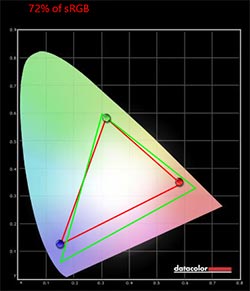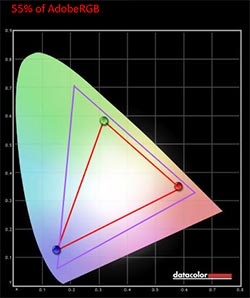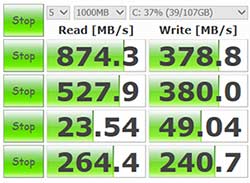Keyboard and Trackpad
The first gen S7 had a very shallow keyboard that was usable but not particularly comfortable. Acer increased key travel from 1.0 to 1.3mm on this second gen model and it really does help, though travel is still shorter than average. It's similar to the Sony Vaio Duo 13 keyboard in terms of travel, but unlike the Duo 13 convertible, you get a full size trackpad that's very usable. Acer uses the same EL backlighting that comes on automatically and glows light blue. The keyboard is inexplicably non-standard with the Fn keys sharing real estate with the numbers, the del key is on the bottom row instead of the top, caps lock is tiny and the Insert key is oversized and located directly above the Enter key (I doubt many folks use Insert all that much).
Display
The S7 has a bright and attractive gloss IPS display with wide viewing angles and 10 points of multi-touch. Thanks to the unique hinge design, you can lay the display flat on the table, and that's where the wide viewing angles shine. Colors are pleasing and saturated, though the display doesn't rate as well as the Sony Vaio Pro 13 and Vaio Duo 13 for color gaming. The full HD, 1920 x 1080 panel provides 72% of sRGB and 55% of Adobe RGB. Brightness measures 336 nits according to our Spyder colorimeter and contrast is a very good 530:1.


Performance and Horsepower
Like the last gen Aspire S7, the SSD is configured in RAID0 for improved speed, and our 128 gig SSD's speed matched and sometimes modestly exceeded the PCIe SSD in the Sony Vaio Pro 13. We're also thrilled that Acer went with 8 gigs of RAM on this machine, since memory is soldered to the motherboard and you won't be able to upgrade it later. Even if you never exceed 4 gigs of RAM, it's nice to know it's there for the future.
As noted with other recent Intel Haswell Ultrabooks like the Sony Vaio 13, Intel's fourth generation doesn't bring significant CPU or graphics performance, but it does extend battery life, and that's something the original S7 needed. Our machine runs on the Intel Core i7-4500U dual core CPU with Intel HD 4400 integrated graphics. As with most Ultrabooks, especially one this thin and light, there's no dedicated graphics option.
Benchmarks
(Core i7-4500U, 8 gigs RAM and 256 gig SSD)
PCMark 7: 5075
wPrime: 22.7 sec.
Windows Experience Index:
Processor: 6.9
RAM: 7.5
Graphics (for desktop): 5.9
Gaming Graphics: 6.5
HDD: 8.3
PCMark 7 Benchmark Comparison Table
CrystalDiskMark SSD Scores

Battery Life
Here's the great news: the second generation Aspire S7 with Haswell inside has competitive runtimes. In fact, it can last 6 hours on a charge with average power management aggressiveness and WiFi on. That's 6 hours of actual usage time and not standby, which consumes very little power. The battery is surprisingly high capacity for such a thin and light machine: 6280 mAh in 4 cells.
Conclusion
If your budget is generous and you have a taste for the best, the Acer Aspire S7 is a top contender. The glass lid, 0.51" slim design and 2.87 lb. weight make for a stylish and attractive Ultrabook that competes nicely with the also very light and chic Sony Vaio Pro 13. The Acer is a bit pricey, but you do get a nice set of upgrades: Core i7 rather than i5 CPU, 8 gigs of RAM and a 256 gig SSD drive that augment performance. Our complaints about the first gen S7's battery life have been addressed and the keyboard has enough travel now that I wouldn't call it punishing. Yes, it's still short travel and the layout is a little odd, but it's not a deal breaker.
Website: www.acer.com
Price: $1,699 as tested, $1,499 for Core i5 model with 128 gig SSD
Related:
HP Spectre 13 Review
Sony Vaio Pro 13 Review
Asus Zenbook UX301 Review
Asus Zenbook UX303 Review
Samsung ATIV Book 9 Plus Review
Lenovo ThinkPad X1 Carbon Review
Dell XPS 13 (FHD) Review
Dell XPS 12 Review
13" MacBook Air Review (Haswell)
13" Retina MacBook Pro Review |

